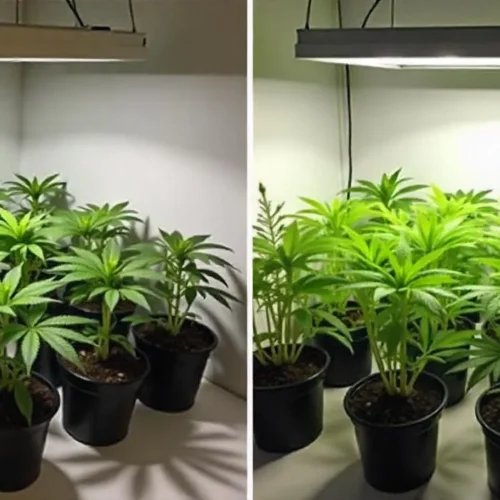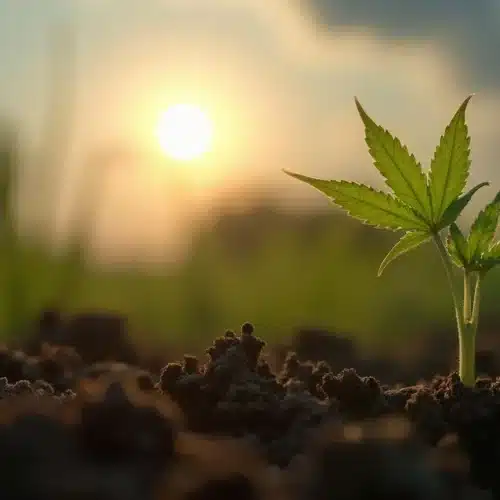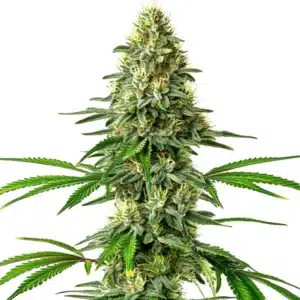When autoflower seeds don’t germinate, it’s often due to factors like unsuitable temperatures, too much or too little moisture, low-quality seeds, or planting them at the wrong depth. Creating optimal conditions and treating the seeds with care are essential for encouraging healthy germination.
When embarking on a journey of cannabis cultivation, the nuances of seed germination is crucial. This initial phase is where the magic begins, with the radicle breaking through the seed coat, marking the start of plant life. Despite various germination methods available, growers often encounter challenges with cannabis seeds not germinating.
Recommended Strains
Zkittlez Kush
 THC: 22% - 24%
THC: 22% - 24% Type of seed: Feminized
Type of seed: Feminized Phenotype: Mostly Indica
Phenotype: Mostly Indica Day to flower: 8 - 10 weeks
Day to flower: 8 - 10 weeks
Zkittlez
 THC: 16% - 20%
THC: 16% - 20% Type of seed: Feminized
Type of seed: Feminized Phenotype: Mostly Indica
Phenotype: Mostly Indica Day to flower: 8 - 10 weeks
Day to flower: 8 - 10 weeks
Preventing Cannabis Seeds Not Germinating
Excess water in seeds when germinating
Seed germination problems, particularly concerning water quantity and germination methods, are common. Many issues arise in cannabis seed germination due to overwatering and excessive soaking. When seeds are soaked or subjected to excessive moisture, they become stagnant and fail to develop properly.
When a cannabis seed begins to germinate, a small white root emerges. However, prolonged soaking in waterlogged conditions can halt root growth and lead to rotting. An indication of root rot is the brown discoloration of the root or its tip. Cannabis roots require both moisture and oxygen to thrive. Prolonged soaking deprives roots of oxygen, leading to root rot.
Conversely, seed germination problems occur when cannabis seeds dry out due to insufficient moisture. This often happens when growers attempt germination between moist cotton pads but forget to seal them in a container. Without adequate moisture, cannabis roots dry out and perish. Observation under high magnification reveals numerous delicate root hairs on the tap root, which dry out and perish without sufficient moisture.
Just as with overwatered seeds, once roots display discoloration and begin to die, they are often irreparably damaged. Soaked cotton pads, saturated tissues, or waterlogged soil in a sealed container all lead to the same issue: hindered root development or complete cessation.
To ensure optimal germination, maintain a moist but not soaked environment for feminized and autoflower seeds. Note that there are no variations in germination techniques between these seed types. It’s important to note that the appearance of a cannabis seed (color, size, shape, etc.) does not affect germination speed.
Promos & Deals
Germinate cannabis seeds outdoors.
Many individuals enjoy initiating the growth of their marijuana seeds outdoors, particularly those cultivating in outdoor or greenhouse settings. It’s a natural inclination, considering seeds have evolved over eons to sprout in such conditions.
Nevertheless, it’s essential to recognize that in nature, a plant can generate hundreds, even thousands, of seeds, yet only a fraction is necessary for the survival of the next generation. Contrary to nature’s laissez-faire approach, cannabis cultivators aim for germination rates of 90% to 100%, especially when investing in premium cannabis seeds tailored to their specific needs and growing environment.
Outdoor growers may encounter challenges with seed germination rates. Depending solely on outdoor conditions can be problematic. Fluctuating weather, particularly during the unpredictable early season, poses significant hurdles. Dramatic temperature swings between day and night can hamper germination and result in the demise of weaker seedlings. Cold, wet weather with prolonged rain may cause seeds to rot underground, hindering emergence. Additionally, pests like slugs, snails, or birds may prey on seedlings.
During heat waves, seeds may desiccate if the roots haven’t reached sufficient depths for moisture absorption. While some seeds may fare well outdoors, it’s not advisable for optimal germination rates. Container germination outdoors presents its own set of challenges. Containers can become excessively hot in direct sunlight, especially dark ones that absorb heat. Temperatures exceeding 35ºC/95ºF can be fatal to seeds or seedlings. Consequently, many successful outdoor cannabis growers opt to germinate seeds indoors, where conditions can be controlled to mitigate germination issues.

Excess heat when seeds germinate
To ensure optimal germination rates for cannabis seeds, it’s crucial to provide adequate moisture and warmth. While seeds may sprout easily at room temperature during summer, colder conditions, especially in winter or in colder areas of your home, can hinder germination. During cooler months, it may be necessary to supplement indoor temperatures with a gentle heat source. Many growers find electric heating mats, which can be set to specific temperatures, invaluable for this purpose.
These heating mats are typically placed beneath plant pots or propagators, providing a consistent warmth ideal for germination, particularly during colder winter periods. However, it’s worth noting that some growers, including the Dutch Passion team, have observed the prolonged use of heating mats throughout the year. While this may seem beneficial, especially during cooler seasons, it can lead to unintended consequences.
In warmer months, excessive heat from continuous mat use can cause overheating of plant containers, potentially damaging or destroying seeds due to high temperatures. It’s important to recognize that when indoor temperatures already reach 20-25°C, additional heat may be unnecessary and pose risks. Overheated soil and sterilized seeds are potential outcomes of prolonged exposure to excessive warmth, particularly when combined with excess moisture.
The accumulation of heat within plant containers, exacerbated by the inability to dissipate excess warmth, can effectively “cook” cannabis seeds and delicate tissues inside, leading to their destruction over time. Hence, it’s essential to monitor and regulate heat sources, ensuring they are used judiciously and in alignment with seasonal requirements to optimize seed germination while mitigating potential risks of overheating and seed damage.
Do not fertilize cannabis seedlings
When seedlings initially emerge, they exhibit heightened sensitivity to their surrounding growth conditions. Intense light in proximity can easily harm their fragile leaf structures. Additionally, extreme temperatures and drastic fluctuations, particularly cold nights, can prove fatal to their development. Hence, meticulous care is essential during the initial 1-2 weeks of seedling growth.
A prevalent oversight observed by the Blimburn Seeds customer support team involves the excessive application of nutrients/fertilizers to seedlings. Cannabis cultivators frequently utilize a diverse array of these substances to nurture their plants, often erring by administering excessive amounts during the early growth phases. In severe instances, such actions can lead to permanent growth retardation or even plant demise.
Seedlings, along with their delicate root systems, struggle to cope with a nutrient-rich environment, as they were not naturally adapted for such conditions. Their seeds contain all the necessary elements for healthy germination and early development, as dictated by nature. Therefore, upon sprouting, seedlings require no fertilization whatsoever!

Effective Seed Germination Techniques: Jiffy Pods, Coffee Filters, and Rockwool Cubes
Among the various germination methods utilized, these specific approaches pose significant challenges and are frequently executed incorrectly. This assertion is supported by customer feedback as well as over 35 years of experience from the Blimburn Seeds customer service team. Over the decades of supplying seeds, Blimburn Seeds, along with their clientele, has amassed substantial knowledge regarding which cannabis seed germination methods are reliable and which are best avoided.
While many growers may attest to the effectiveness of these methods, their success is not universally guaranteed, as evidenced by the extensive experience of the Blimburn Seeds team.
Some growers have found success with cannabis seed germination using jiffy pods. However, the Blimburn Seeds team is cautious, noting that these methods lack the same foolproof reliability and wide applicability as the preferred method of germinating cannabis seeds between moist cotton pads.
Based on Blimburn Seeds experience, there are numerous ways to improperly execute cannabis seed germination using jiffy pods, coffee filters, and rock wool cubes. Consequently, opting for a safer, more dependable method with greater versatility and reduced risk of error is advisable. Therefore, Blimburn Seeds advises customers against their usage.
Beware of damping in cannabis plants
Damping off’ is a condition impacting young seedlings, triggered by various fungi and fungus-like organisms. This ailment leads to weak stems incapable of supporting emerging seedlings, resulting in their collapse often under a white fungal layer. Damping off primarily affects young seedlings and is often linked to overwatering or using contaminated soil, such as from your backyard. Common pathogens responsible for damping off include Rhizoctonia, Fusarium, and Pythium, with Pythium frequently carried by fungus gnats, common pests in composted wood soils. Unfortunately, once damping off sets in, there are limited options for saving affected seedlings.
Tackling Stretching Seedlings: Remedies for Lack of Light in Plant Growth
Following successful germination of your cannabis seeds, it’s crucial to provide optimal care for your seedlings. This entails attention to lighting, a pivotal factor for robust plant growth.
Upon sprouting, it’s imperative to ensure your seedlings receive high-quality illumination, whether from natural sunlight or artificial indoor grow lights.
Excessive lighting can be detrimental, potentially fatal to delicate new seedlings. Some growers prefer utilizing specialized ‘T5’ fluorescent tubes or LED light bars tailored for seedling cultivation. Conversely, inadequate lighting prompts seedlings to elongate in search of light, leading to potential complications or even death as the elongated stem struggles to support itself.
Lighting remains paramount in cannabis plant cultivation. Insufficient illumination results in stretched-out plants with sparse, undersized leaves. Given that leaves serve as the “solar panels” gathering energy for flower development, low light conditions invariably yield minimal harvests.

Selecting the Correct Soil for Successful Seed Germination
From time to time, the customer service team at Blimburn Seeds encounters customers who opt to utilize soil from their backyard for sprouting cannabis seeds. This practice is typically observed as a novice mistake or an effort to expedite the process and cut costs. However, it is strongly discouraged.
While occasionally the soil may possess adequate quality, facilitating seed germination without complications, oftentimes it is either too sandy or excessively dense due to a high clay content. Additionally, garden soil may harbor detrimental mold, fungi, pests, or excessive fertilizers. Frequently, growers resort to using soil from their compost pile for seedlings.
The rationale behind this choice is the perception of freshness, naturalness, and suitability for cultivation. Nevertheless, freshly composted soil tends to be excessively nutrient-rich, which is ideal for mature plants but potentially toxic for delicate seedlings, which require minimal or no nutrition.
In instances where garden soil is employed, one might observe the development of mold on the soil surface, resulting in a white discoloration. Seedlings affected by mold are at a heightened risk of damping off and perishing.
Planting marijuana seeds excessively deep in the ground
To ensure optimal germination of your cannabis seeds, avoid burying them too deeply. A depth of 3-5mm for both autoflower and feminized seeds is ideal, with a maximum depth of 10mm. Deep burial can hinder the seed’s journey to the surface, increasing the risks of rot, overheating, and damage. While some growers scatter seeds on the soil’s surface, akin to sowing a grain field, this method is not advisable for consistent results.

Grandaddy Gorilla Auto
Grandaddy Gorilla Auto is an autoflowering cannabis strain known for its unique genetic characteristics and potent high. This strain is the result of crossing Grandaddy Purple, Gorilla Glue and an autoflowering variety, giving it a unique combination of genetic traits.
In terms of appearance, Grandaddy Gorilla Auto plants are typically compact and robust, with deep green leaves and dense resin-coated buds. Their autoflowering life cycle means they automatically flower after a set period of time, regardless of light exposure, making them easy to grow both indoors and outdoors.
In terms of its cannabinoid and terpene profile, Grandaddy Gorilla Auto tends to have high levels of THC (15%-20%), the main psychoactive compound in cannabis, resulting in a potent and long-lasting effect. Additionally, its genetic heritage includes terpenes that can offer a wide range of aromas and flavors, ranging from sweet and fruity notes to earthy and musky undertones.
Users typically experience a predominantly indicative effect, characterized by a feeling of deep relaxation both physically and mentally. This makes it ideal for use at night or in situations where you seek to relieve stress, anxiety or insomnia.
Mac Rillaz F1
Are you in search of a potent cannabis strain that provides a balanced high? Look no further than Mac Rillaz F1. This exceptional hybrid combines the best of both indica and sativa varieties, delivering robust potency alongside invigorating effects. Let’s delve into what sets this strain apart.
To cultivate your own Mac Rillaz F1 plants, begin by planting seeds in soil, whether indoors or outdoors. Optimal temperatures range between 70 to 80 degrees Fahrenheit (21 to 27 degrees Celsius), ensuring ideal growth conditions. Adequate watering is crucial to prevent nutrient deficiencies and maximize yields. Additionally, ample light exposure, preferably from high-intensity discharge lighting, is essential for healthy development.
Mac Rillaz F1 caters to a diverse range of preferences and needs. Whether seeking relief from physical discomfort or seeking relaxation after a long day, this strain delivers consistent satisfaction. Its versatile genetics blend indica and sativa characteristics, offering a potent yet functional high. With THC concentrations reaching up to 30%, Mac Rillaz F1 stands as one of the most potent strains available, delivering powerful psychoactive effects without excessive sedation.
Adorned with vibrant green and purple hues, Mac Rillaz F1 boasts visually striking buds adorned with glistening crystals. Breaking open these buds releases an enticing aroma reminiscent of pine, citrus, pepper, and wood.
Zkittlez Kush
Zkittlez Kush emerges as a highly coveted cannabis strain due to its dominant Indica properties and distinctive flavor profile. Curious about what sets it apart? Delve into this comprehensive review for all the essential insights.
Zkittlez Kush boasts a sugary scent reminiscent of ripe fruits, leaving a tantalizing aftertaste of cherries, grapes, and oranges upon exhale. Its sweet, aromatic profile is complemented by subtle spice notes and an earthy undertone, with a lingering hint of creamy lemonade.
Don’t overlook the potent effects of this Indica-dominant hybrid. Known for inducing a profound sense of calm and relaxation, it’s prized for alleviating stress and anxiety. Moreover, it enhances focus, creativity, and mental tranquility, offering potential relief for individuals battling depression.


















